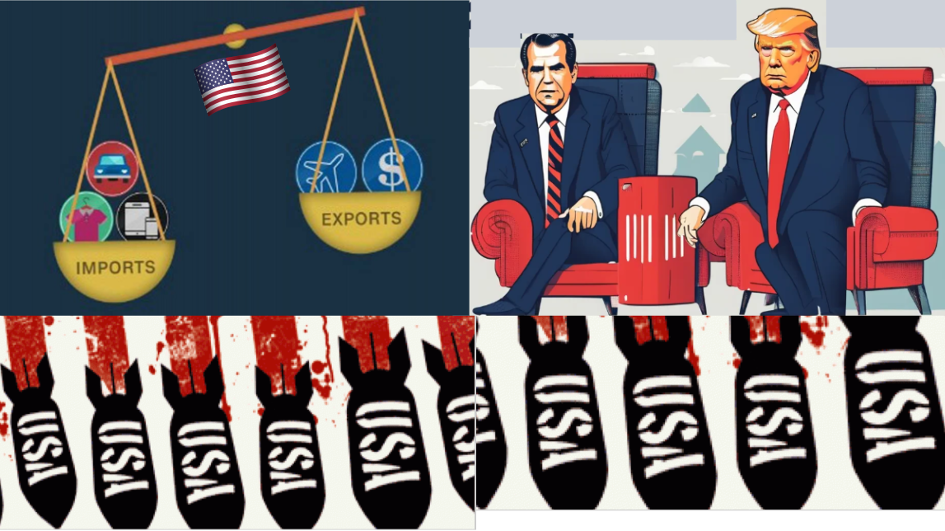Felix Abt: The Nixon Shock and Trump’s Tariffs: Parallel Responses to Military Setbacks
The Nixon Shock of the early 1970s and the economic policies of the Trump administration share striking parallels, rooted in how both leaders confronted U.S. economic pressures following costly military engagements. Each era saw America grappling with systemic current account deficits, prompting radical shifts in economic strategy to preserve global dominance.
Felix Abt

The Nixon Shock: Severing the Dollar-Gold Link
Under the Bretton Woods system (1944–1971), major currencies were pegged to the U.S. dollar, which was convertible to gold at $35 per ounce. By the late 1960s, however, mounting U.S. trade deficits and foreign governments’ demands for gold in exchange for dollar reserves—exacerbated by massive spending on the Vietnam War, the Great Society programs, and the Space Race—depleted U.S. gold reserves. Faced with dwindling confidence in the dollar, Nixon unilaterally ended gold convertibility in 1971, effectively dismantling Bretton Woods.
To stabilize the dollar’s global role, Nixon’s negotiators struck a deal with Saudi Arabia in 1974, ensuring oil sales would be denominated in dollars. This “petrodollar” system entrenched the dollar as the world’s reserve currency, allowing the U.S. to finance persistent deficits without immediate economic collapse.
Vietnam’s Shadow: Economic Overstretch and Policy Shifts
The Vietnam War (1955–1975) proved pivotal. The conflict diverted U.S. industrial capacity toward military production, hollowing out civilian manufacturing and fueling reliance on imports. Combined with domestic social spending and Cold War military investments, this overextension strained the economy. By 1971, the U.S. faced stagflation—a toxic mix of inflation and stagnation—compelling Nixon’s drastic monetary reforms.
Critically, the Nixon Shock occurred before Saigon’s 1975 fall. Though the war’s outcome was increasingly clear by 1971, the U.S. sought a “peace with honor” façade, masking the reality of strategic defeat.
Trump’s Tariffs and the Ukraine War Echo
Decades later, Trump’s tariffs—particularly targeting China—mirror Nixon’s unilateralism. Just as Nixon addressed deficits by decoupling from gold, Trump sought to counter trade imbalances and deindustrialization through protectionism. Behind this lies another military quagmire: Ukraine.
Since 2022, the U.S. has funneled aroud $ 200,000,000,000 in aid to Ukraine while leading unprecedented sanctions against Russia. Yet, as with Vietnam, the war has yielded diminishing returns. Despite bipartisan rhetoric about Ukrainian victory, the conflict has stalemated, with Russia consolidating territorial gains. The toll of the Washington-led economic war—including global energy disruptions and inflation as well as Europe’s de-industrialization and falling living standards—is leading to the end of Western cohesion.
Geopolitical Gambits: From Kissinger’s China Pivot to Trump’s Russia Outreach
Nixon’s 1972 China détente aimed to isolate the USSR, exploiting Sino-Soviet tensions. Today, Trump’s reported overtures to Russia reflect an inverted strategy: courting Moscow to counterbalance China. However, this ignores the deepening Sino-Russian alliance, solidified through energy deals, mutual sanctions resistance, and joint military exercises. Unlike the 1970s, when Mao’s China distrusted Moscow, Putin and Xi’s “no limits” partnership renders such wedge tactics obsolete.
The Unraveling of the “Collective West”
Recent U.S. troop drawdowns in Poland and Greece signal a quiet disengagement from Ukraine, mirroring Nixon’s Vietnam wind-down. By transferring logistics to European allies such as Greece and Poland, the U.S. appears to prioritize reallocating resources toward Asia—a recognition of China, not Russia, as the primary adversary. Concurrently, Trump’s threats to bypass EU sanctions on Russia suggest a broader transatlantic rift.
Conclusion: Cycles of Overreach and Adjustment
Both the Nixon and Trump shocks underscore how military overextension accelerates economic reckoning. The Vietnam and Ukraine conflicts, though distinct in scale, forced costly policy pivots to address structural vulnerabilities. Yet today’s multipolar world complicates U.S. strategy: China’s economic heft and the Sino-Russian entente offer no easy “cards” to play. As in 1971, unspoken acknowledgment of defeat may drive current shifts—but whether tariffs or troop withdrawals can offset decline remains uncertain. The larger lesson endures: unsustainable military commitments ultimately exact domestic economic tolls, compelling leaders to redefine global engagement, often abruptly.
More on his Substack and his YouTube channel
30 thoughts on “Felix Abt: The Nixon Shock and Trump’s Tariffs: Parallel Responses to Military Setbacks”